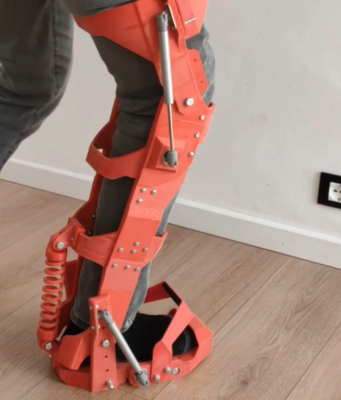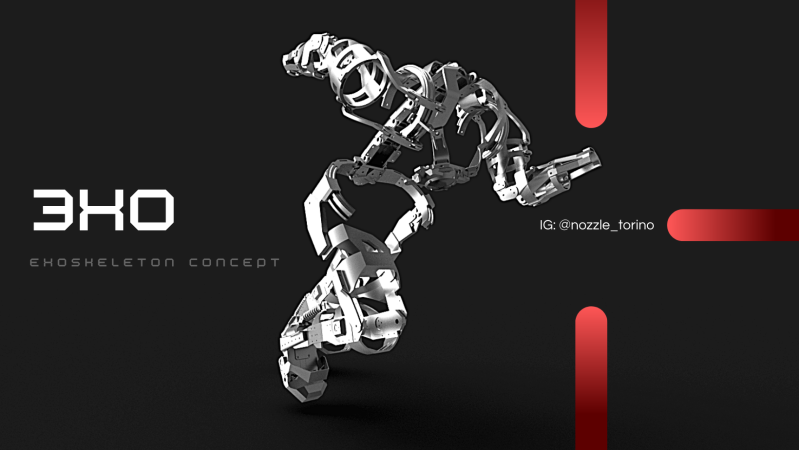While not quite in a cave, the idea of making your own exoskeleton with limited tools does have a Tony Stark esque vibe. [Andrew Piccinno] is a mechanical engineer pursuing the dream of 3D printing a full-body exoskeleton called 3X0. It’s a project he’s been ruminating on since college, but the work really began in earnest about five months ago. Unfortunately, there are too many pictures to include here, but check out his Instagram or makeprojects for more photos.

To make sure parts fit, [Andrew] started with creating a mesh of his body. After running fifty pictures of himself holding relatively still through some photogrammetry software, he had a decent mesh. While measurements weren’t millimeter-accurate, the relative sizes of everything were reasonably accurate. While the design is modeled with his measurements in mind, all the different pieces are parametric, which in theory would allow someone to tweak the designs to fit their own body.
So far, all the parts have been entirely 3D printed, except for steel balls bearings, gas pistons, and tension bands. The non-3D printed parts are picked to be easy to obtain as the gas piston is just 100 N furniture pistons. The design process includes quite a bit of math, motion study, and simulation to make sure the part that he’s printing will not only fit but move correctly. Many parts, such as the shoulder, are built around a large custom bearing that allows the piece to move correctly with the user’s joints.
While still in the middle of development, [Andrew] has made some serious progress, and we’re looking forward to seeing it completed. The current design is primarily passive with just a few springs and pistons, but he is already looking forward to making it active to the degree that it can augment a user’s motions rather than just taking the load off. It’s clear that [Andrew] believes that exoskeletons are a look into a potential future, and we couldn’t agree more. In a similar vein, perhaps the techniques used in this powered exoskeleton arm on a budget could be used to power the 3X0?
















Good intentions, bad idea. In case of an accident his injuries may not be covered by insurance.
But if he gets a lethal dose of radiation at work, he’s all set to storm Elysium!
Looks like it’s at the fun rather than dangerous end of the spectrum. Wouldn’t say it’s a bad idea at all. Probably safer than crossing a road anywhere in a large city during busy hours and we all do that (ideally with due care at crossings).
There seem to be renderings of a metal version. That might be a little more dangerous due to weight and likely more powerful actuators.
Current design is fully passive and 3D printed, it is safe to use as long as it is well designed, there is nothing getting actuated, so little risk of damage. First tests powered should be done either without anyone in it or with a maniken.
mannequin*
That’s right, I am developing a first passive version now just to check the overall kinematic. I’ll think about powering it in next version.
hammer industries…. 20 years away from a working powered suit.
Better to compress those 20 years then
It must be so strange to live in America and having to worry about insurance etc for illness/injury.
It is, how do you think I’m on this forum, can’t afford leg braces for my CP
But I live in Italy :) anyway I am being enough careful with the test so finger crossed
Insurance exists precisely for in case of injury, there’s no reason to think anything he’s doing wouldn’t be covered under a typical rider.
probably shouldnt do anything… too much liability. Why would you read this website? its primary focus is being creative and not using things as intended…
I wonder if he’s doing any air muscle work? Shadow Robotics has done some beautiful work with them, and they are really approachable for the hobby tinkerer/low budget researcher. I’m pretty convinced that any actually practical exoframe will use them.
But would compressors, tanks, valves, etc. offer a power to weight ratio that servos and batteries can? Maybe so – I haven’t done the research to know. But the one down side to air muscles seems to be fine control? a valve is either open or closed right? or maybe a fancy valve and back pressure can create more control – i’ll have to check out Shadow Robotics. Festo has nice looking stuff too. Either way – lots of cool problems to solve! This looks like a fun project!
Not really a valve can be partially opened – when you turn a tap on the flow doesn’t immediately come out full speed, you have to keep winding the tap to get the full flow speed, the same can be done deliberately with any valve in a fluid system (even a compressible fluid like air)…
Power to weight is a tricky one – if you are powering the whole thing off a compressed air tank as a ‘battery’ then the weight of the compressor is irrelevant – its not part of the suit, and if you are not you then need battery or something else to power the compressor..
Many ‘soft’ air robotic projects seem to be vastly lighter in the actual functional moving element compared to an equivalent motor, gearbox, actuator combination, however they are usually taking up more more volume. Also the energy density of your compressed air tank is probably not even close to the battery, and you probably want electronic controls so will need an electrical system too, so the energy store is bigger and you probably end up running both in the air powered system….
It’s simple, you need the arc reactor..
You do better tensioning antagonistic actuators and varying the pressure differential between them using proportional valves. As you can see by festos arm, precise control is quite possible. https://youtu.be/2iG1ybuchx0
He might consider either skinning the prints with a composite or making a mold with the models and laminating. I’ve had a lot of success making carbon and glass parts this way.
Hey man, yeah that’s the plan I have for next version. Currently I am at first concept to check the overall kineamtics but later on I’ll go in that direction
This is exactly the kind of thing we need to get full body force feedback for VR.
I was hoping this to be one of the applications! Let’s see
Interesting idea. Your power actuators should mimic muscle. Your attachment points should where normal muscles attach. Hydraulics will leak. Pneumatic will leak but will not burn. Look to the experiment from MIT and the Artificial Fish. Then your only concern will be power consumption rate. Just like SARCO found out.